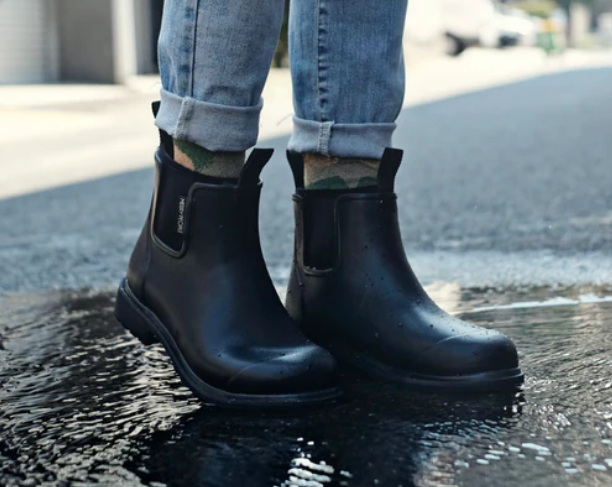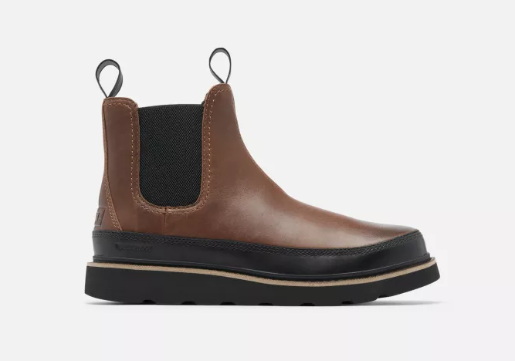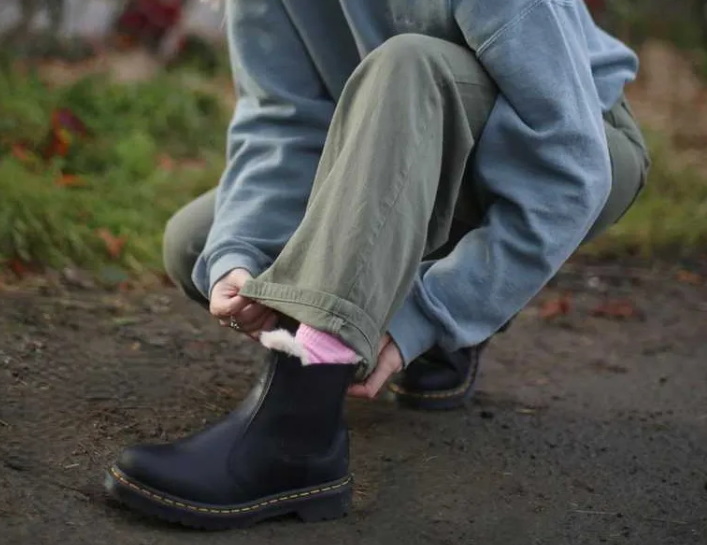Content Menu
● The Nature of Leather Chelsea Boots
● Water Resistance vs. Waterproofing
● Factors Affecting Water Resistance
● Natural Water Resistance of Leather
● The Chelsea Boot Design
● Waterproofing Leather Chelsea Boots
>> 1. Cleaning and Conditioning
>> 2. Applying Waterproofing Products
>> 3. Professional Waterproofing
● Maintaining Water Resistance
● Alternatives for Wet Weather
● The Trade-off: Waterproofing vs. Breathability
● When to Wear Leather Chelsea Boots in Wet Conditions
● The Impact of Water on Leather
● Caring for Water-Damaged Chelsea Boots
● The Environmental Consideration
● Conclusion
● FAQ
>> 1. How often should I waterproof my leather Chelsea boots?
>> 2. Can I use household items to waterproof my Chelsea boots?
>> 3. Will waterproofing change the appearance of my Chelsea boots?
>> 4. Are suede Chelsea boots more difficult to waterproof than smooth leather?
>> 5. Can I wear my leather Chelsea boots in snow?
● Citations:
Chelsea boots are a timeless and versatile footwear option that has been popular for over a century. With their sleek design and slip-on convenience, they've become a staple in many wardrobes. However, when it comes to wet weather, a common question arises: Are leather Chelsea boots waterproof? Let's dive deep into this topic and explore the water-resistant properties of these iconic boots.

The Nature of Leather Chelsea Boots
Chelsea boots are typically made from leather, which is a natural material known for its durability and flexibility. While leather itself has some inherent water-resistant properties, it's important to understand that most leather Chelsea boots are not completely waterproof by default[1][2].
Water Resistance vs. Waterproofing
Before we proceed, it's crucial to distinguish between water resistance and waterproofing:
- Water Resistance: The ability to repel water to some degree, but not completely.
- Waterproofing: The ability to prevent water from penetrating entirely.
Most leather Chelsea boots fall into the water-resistant category rather than being fully waterproof[5].
Factors Affecting Water Resistance
Several factors influence how well leather Chelsea boots can handle water:
1. Leather Quality: Higher quality, full-grain leather tends to be more naturally water-resistant than lower-grade leathers[8].
2. Construction: The way the boot is constructed, especially around the seams and soles, plays a significant role in its ability to keep water out[9].
3. Treatment: Whether the leather has been treated with waterproofing products can greatly enhance its water resistance[10].
4. Wear and Tear: Over time, the natural oils in leather can diminish, reducing its water-resistant properties[11].
Natural Water Resistance of Leather
Leather has some natural water-resistant properties due to its fibrous structure and the presence of natural oils. When water droplets land on well-maintained leather, they often bead up and roll off rather than immediately soaking in[12]. However, this natural resistance has its limits and can be overwhelmed by prolonged exposure to water or heavy rain.
The Chelsea Boot Design
The design of Chelsea boots can both help and hinder their water resistance:
- Elastic Side Panels: The signature elastic panels on Chelsea boots can be a weak point for water entry[9].
- Ankle Height: The higher ankle design provides some protection against shallow puddles.
- Lack of Laces: The absence of lace holes eliminates one potential entry point for water.
Waterproofing Leather Chelsea Boots
While most leather Chelsea boots aren't inherently waterproof, there are steps you can take to enhance their water resistance:
1. Cleaning and Conditioning
Before applying any waterproofing treatment, it's essential to clean and condition your boots:
1. Remove dirt with a soft brush.
2. Clean with a leather cleaner.
3. Apply a leather conditioner to keep the leather supple[15].
2. Applying Waterproofing Products
There are several types of waterproofing products available:
- Waxes: Provide a thick, durable layer of protection[7].
- Creams: Offer a balance between protection and breathability.
- Sprays: Easy to apply but may need more frequent reapplication[8].
3. Professional Waterproofing
Some cobblers offer professional waterproofing services, which can be more thorough and long-lasting than DIY methods[16].
Maintaining Water Resistance
To keep your Chelsea boots water-resistant:
1. Regularly clean and condition the leather.
2. Reapply waterproofing treatments as needed.
3. Allow boots to dry naturally if they get wet.
4. Use a boot tree to maintain shape and absorb moisture[17].
Alternatives for Wet Weather
For extremely wet conditions, consider alternatives:
- Rubber Chelsea Boots: Fully waterproof options are available[12].
- Weatherproof Leather: Some manufacturers offer Chelsea boots made with specially treated waterproof leather[5].

The Trade-off: Waterproofing vs. Breathability
It's important to note that increasing water resistance can affect the leather's breathability. Heavily waterproofed leather may not allow moisture from your feet to escape as easily, potentially leading to discomfort[18].
When to Wear Leather Chelsea Boots in Wet Conditions
While enhanced water resistance can protect your boots in light rain or brief encounters with water, it's best to avoid wearing leather Chelsea boots in heavy rain or deep puddles. For such conditions, purpose-built waterproof footwear is more suitable[19].
The Impact of Water on Leather
Prolonged exposure to water can have several negative effects on leather:
1. Staining: Water can leave marks on leather, especially lighter colors.
2. Shape Distortion: Excessive moisture can cause the leather to stretch or shrink.
3. Cracking: As wet leather dries, it can become stiff and prone to cracking.
4. Reduced Lifespan: Repeated wetting and drying can break down the leather fibers over time[20].
Caring for Water-Damaged Chelsea Boots
If your Chelsea boots do get soaked:
1. Stuff them with newspaper to absorb moisture.
2. Allow them to dry at room temperature, away from direct heat.
3. Once dry, condition the leather to restore oils.
4. If severe damage occurs, consult a professional cobbler[21].
The Environmental Consideration
When choosing waterproofing products, consider their environmental impact. Some traditional waterproofing chemicals can be harmful to the environment. Look for eco-friendly alternatives that offer protection without compromising sustainability[22].
Conclusion
While leather Chelsea boots are not inherently waterproof, they can be made more water-resistant through proper care and treatment. Understanding the limitations of leather in wet conditions and taking steps to protect your boots can significantly extend their lifespan and versatility. Remember that no amount of waterproofing will make leather Chelsea boots suitable for extreme wet conditions, and it's always best to choose footwear appropriate for the weather you'll encounter.

FAQ
1. How often should I waterproof my leather Chelsea boots?
The frequency of waterproofing depends on how often you wear your boots and in what conditions. As a general rule, apply waterproofing treatments every 3-6 months, or more frequently if you often wear them in wet conditions[23].
2. Can I use household items to waterproof my Chelsea boots?
While some household items like beeswax or coconut oil can provide some water resistance, it's best to use products specifically designed for leather waterproofing to ensure effectiveness and avoid potential damage to the leather[24].
3. Will waterproofing change the appearance of my Chelsea boots?
Some waterproofing products, especially waxes, may slightly darken the leather or alter its finish. Always test the product on a small, inconspicuous area first[25].
4. Are suede Chelsea boots more difficult to waterproof than smooth leather?
Yes, suede is generally more challenging to waterproof due to its napped texture. Special suede waterproofing sprays are available, but they may change the texture of the suede slightly[26].
5. Can I wear my leather Chelsea boots in snow?
While waterproofed leather Chelsea boots can handle light snow, they are not ideal for deep snow or prolonged exposure to winter conditions. For snowy weather, consider boots specifically designed for winter use[27].
Citations:
[1] https://us.wills-vegan-shoes.com/products/vegan-waterproof-chelsea-boots-mens
[2] https://www.fashionbeans.com/article/waterproofing-leather-boots/
[3] https://www.youtube.com/watch?v=wG9JR0ui1H4
[4] https://www.scarosso.com/en-us/men/shoes/chelsea-boots/
[5] https://www.bogsfootwear.com/shop/style/73112.html
[6] https://taosfootwear.com/blogs/shoe-muse/the-ultimate-waterproof-leather-boot-guide-for-rainy-days
[7] https://nicksboots.com/blog/post/how-to-waterproof-leather-work-boots/
[8] https://www.shoezone.com/Blog/how-to-waterproof-boots-shoes-your-complete-guide
[9] https://www.reddit.com/r/Boots/comments/19cdhpo/are_chelsea_boots_good_for_rain/
[10] https://www.freepik.com/free-photos-vectors/chelsea-boot
[11] https://pfworkwear.com/care-guide-for-leather-boots-and-shoes/
[12] https://uk.merrypeople.com/blogs/adventures/are-chelsea-boots-waterproof
[13] https://www.timberland.com/en-us/faq/how-to-waterproof-boots-and-shoes?ew=0
[14] https://www.blundstone.com/black-premium-waterproof-leather-chelsea-boots-mens-style-566
[15] https://www.instructables.com/Waterproof-boots/
[16] https://www.timberland.com/en-us/faq/how-to-waterproof-boots-and-shoes?ew=0
[17] https://www.instructables.com/Boot-Waterproofing/
[18] https://www.blundstone.com/black-premium-waterproof-leather-chelsea-boots-womens-style-566
[19] https://www.istockphoto.com/de/bot-wall?returnUrl=%2Fde%2Fphotos%2Fchelsea-boots
[20] https://www.velascawomen.com/products/bagaj-dnm
[21] https://www.youtube.com/watch?v=wG9JR0ui1H4
[22] https://www.velasca.com/collections/chelsea-boots
[23] https://thursdayboots.com/collections/mens-boots-chelsea
[24] https://www.archerytalk.com/threads/how-waterproof-are-waterproof-leather-boots.5831701/
[25] https://www.reddit.com/r/goodyearwelt/comments/77am8t/updated_introductory_leather_care_guide/
[26] https://www.reddit.com/r/goodyearwelt/comments/psjb0j/gyw_faq_waterproofing/
[27] https://bobistheoilguy.com/forums/threads/best-way-to-waterproof-leather.349215/
[28] https://stridewise.com/how-to-waterproof-nice-boots/

















